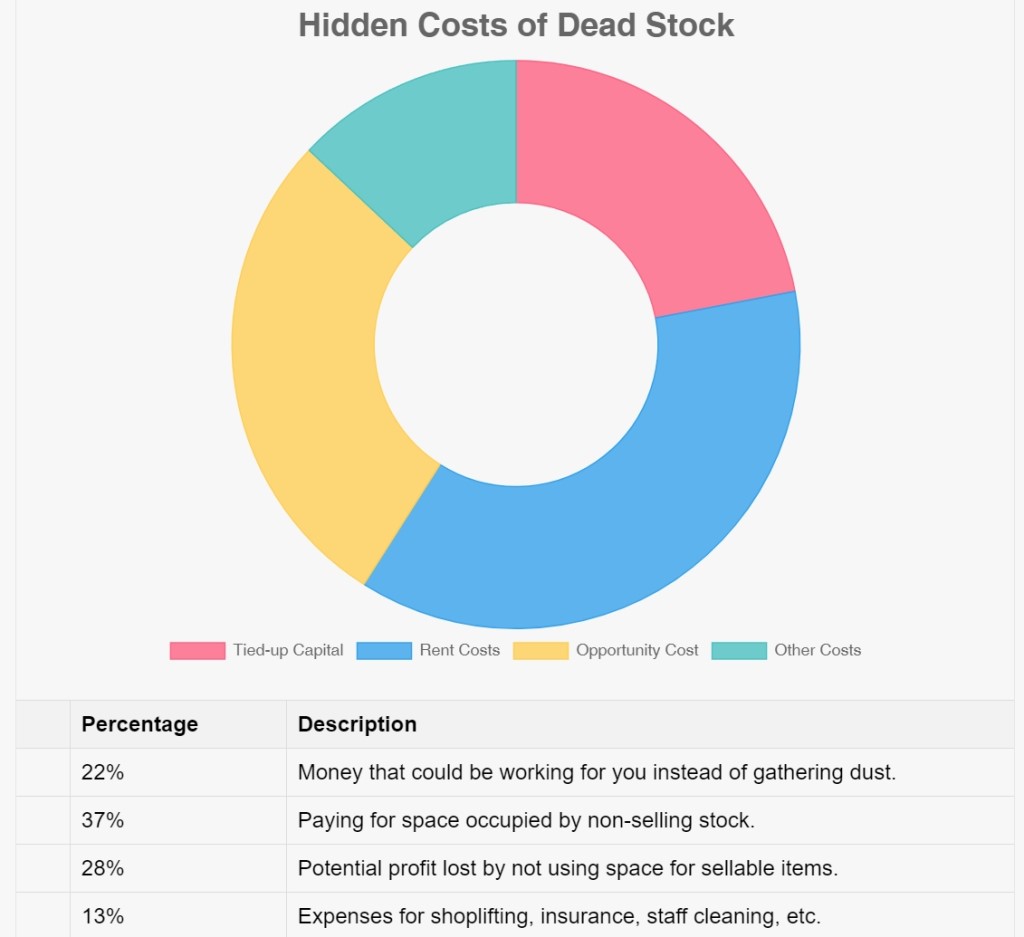We have all experienced inventory nightmares. The most persistent one is dead stock. It sits there, and you see it everywhere in the shop. It is a silent killer of profits, a space hogger in your shop, and a constant reminder of a wrong purchasing decision. Here are some battle-tested strategies used. Often, they are painful, but they do work.
What is Dead Stock
Dead stock is stuff that's not selling. It's inventory that is now growing roots in your shop. I recently saw a shop with items on the shelf that were a few years old. They did not even look sellable.
What is the dead stock analysis?
Deadstock analysis involves:
-Identifying non-selling inventory
-Calculating the cost of holding this inventory
-Determining reasons for lack of sales
-Assessing the impact on profitability and cash flow
-Developing strategies to prevent and manage dead stock
The Hidden Costs

Tied-up capital
That money could be working for you instead of gathering dust.
Rent costs
You are paying for every square metre of your shop; here, you are paying for space for nothing as the stock there is not selling.
Opportunity cost
You could be stocking items there that sell instead.
Other costs
You are paying for shoplifting, insurance, staff cleaning, etc. All for stock that does not sell.
How do you determine dead stock?
Here's how you spot dead stock: Set up specific criteria. Different retailers use different rules.
Time
Items that haven't sold in 6-12 months (varies by shop and industry)
Excess inventory beyond reasonable selling expectations
Products with little to no customer interest. Your staff will know this.
Outdated or obsolete products
Also, check for obsolescence; the sale cycle is only a month in fast-moving stock lines on movie toys.
Quantity
Selling less than 60% of purchased inventory
Damaged or unsellable condition
Look at your shelves for outdated, damaged, or low-quality items. Listen to your staff as they often know these items.
What is a dead stock register?
A dead stock register is a record-keeping system that tracks an organisation's movable property or assets that are no longer in use or have no sales potential. It includes product name, buy date, quantity, and current condition. Your POS system should have one, and its weight should be gold for tracking dead stock. If you have our POS System, follow the instructions here. It will take seconds to give you the result. I have seen results of over $50,000 of dead stock coming out.
Regular stock reviews.
I make it a habit to review my inventory quarterly.
Strategies for clearing Dead Stock
Alright, you've identified the dead weight. Now what? Here are some tactics I've used successfully:
Discount, But Do It Smart
Slashing prices is the go-to move, but be strategic. I want it out.
How do you clear stock quickly?
Nothing beats flash sales to clear stock quickly. In my experience, end-of-financial-year and stocktaking sales work very well.
Bundle It Up
This is my go-to method. I find that pairing my dead stock with an item that sells and then using the item that sells as a push for a dead stock item works well. I offered my clients some monitors with a screen filter. From my client's point of view, they were getting a monitor and screen filter together at a beautiful price; from my point of view, I was moving monitors with something that had no value to me. It was a win-win situation.
Try a new sales channel
If it's not selling in your shop, try online marketplaces. I've had success moving dead stock on eBay. You could also try Facebook Marketplace.
Use it yourself
Sometimes, you can use the products yourself. You do not need them, but consider them something you got for nothing.
Donate
Sometimes, it is best to cut your losses. I donated to a charity, which bought a pile of old computer parts for free. We got a tax deduction, and we felt good about doing something for the community.
Preventing Future Dead Stock
The best way to deal with dead stock is to prevent it. Here's how:
Improve your forecasting
Use your POS data to predict trends and seasonal fluctuations
Implement just-in-time inventory
To reduce risk, you want to keep your stock levels lean, so buy in small quantities and regularly rather than in large orders. Your automatic ordering in our POS System can handle small orders over a short period.
Can you get a sale or return
It is often worth giving up some margin if you can get this, If, say, you were to buy ten items and be stuck with an item in dead stock at a 50% margin, your actual margin is now 44% If, say, you were to buy ten items and be stuck with two items dead at a 50% margin, your actual margin is now 37.5% If, say, you were to buy ten items and be stuck with three items dead at a 50% margin, your actual margin is now 28%
The Role of Technology
A robust POS system with inventory management features can help. Here's why:
Real-time tracking
Know what's in stock and what's selling at any given moment.
Automated reordering
Set up alerts for low stock to prevent stockouts of popular items
Sales reporting
Identify trends and slow movers before they become dead stock
How do you write off dead stock?
If you do not get rid of it but want to write it off, you need to ensure proper documentation to your accountant for tax purposes
-Identify the items you will write off
-Determine the book value of the dead stock. Your POS System should have that.
-Note a journal entry to the accountant to remove the value from inventory assets.
-Do not adjust the cost price in your POS data unless you intend never ever to order that item again.
Conclusion
Deadstock is a retail reality but doesn't have to be a business killer.


